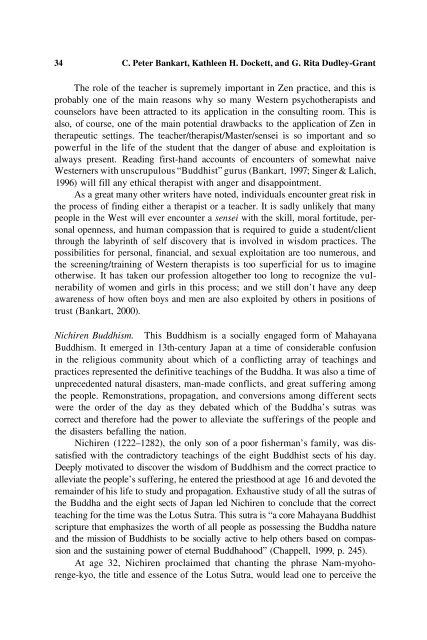Psychology & Buddhism.pdf
Psychology & Buddhism.pdf
Psychology & Buddhism.pdf
You also want an ePaper? Increase the reach of your titles
YUMPU automatically turns print PDFs into web optimized ePapers that Google loves.
34 C. Peter Bankart, Kathleen H. Dockett, and G. Rita Dudley-Grant<br />
The role of the teacher is supremely important in Zen practice, and this is<br />
probably one of the main reasons why so many Western psychotherapists and<br />
counselors have been attracted to its application in the consulting room. This is<br />
also, of course, one of the main potential drawbacks to the application of Zen in<br />
therapeutic settings. The teacher/therapist/Master/sensei is so important and so<br />
powerful in the life of the student that the danger of abuse and exploitation is<br />
always present. Reading first-hand accounts of encounters of somewhat naive<br />
Westerners with unscrupulous “Buddhist” gurus (Bankart, 1997; Singer & Lalich,<br />
1996) will fill any ethical therapist with anger and disappointment.<br />
As a great many other writers have noted, individuals encounter great risk in<br />
the process of finding either a therapist or a teacher. It is sadly unlikely that many<br />
people in the West will ever encounter a sensei with the skill, moral fortitude, personal<br />
openness, and human compassion that is required to guide a student/client<br />
through the labyrinth of self discovery that is involved in wisdom practices. The<br />
possibilities for personal, financial, and sexual exploitation are too numerous, and<br />
the screening/training of Western therapists is too superficial for us to imagine<br />
otherwise. It has taken our profession altogether too long to recognize the vulnerability<br />
of women and girls in this process; and we still don’t have any deep<br />
awareness of how often boys and men are also exploited by others in positions of<br />
trust (Bankart, 2000).<br />
Nichiren <strong>Buddhism</strong>. This <strong>Buddhism</strong> is a socially engaged form of Mahayana<br />
<strong>Buddhism</strong>. It emerged in 13th-century Japan at a time of considerable confusion<br />
in the religious community about which of a conflicting array of teachings and<br />
practices represented the definitive teachings of the Buddha. It was also a time of<br />
unprecedented natural disasters, man-made conflicts, and great suffering among<br />
the people. Remonstrations, propagation, and conversions among different sects<br />
were the order of the day as they debated which of the Buddha’s sutras was<br />
correct and therefore had the power to alleviate the sufferings of the people and<br />
the disasters befalling the nation.<br />
Nichiren (1222–1282), the only son of a poor fisherman’s family, was dissatisfied<br />
with the contradictory teachings of the eight Buddhist sects of his day.<br />
Deeply motivated to discover the wisdom of <strong>Buddhism</strong> and the correct practice to<br />
alleviate the people’s suffering, he entered the priesthood at age 16 and devoted the<br />
remainder of his life to study and propagation. Exhaustive study of all the sutras of<br />
the Buddha and the eight sects of Japan led Nichiren to conclude that the correct<br />
teaching for the time was the Lotus Sutra. This sutra is “a core Mahayana Buddhist<br />
scripture that emphasizes the worth of all people as possessing the Buddha nature<br />
and the mission of Buddhists to be socially active to help others based on compassion<br />
and the sustaining power of eternal Buddhahood” (Chappell, 1999, p. 245).<br />
At age 32, Nichiren proclaimed that chanting the phrase Nam-myohorenge-kyo,<br />
the title and essence of the Lotus Sutra, would lead one to perceive the











